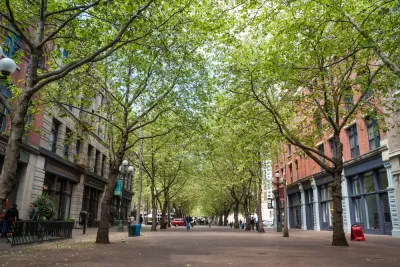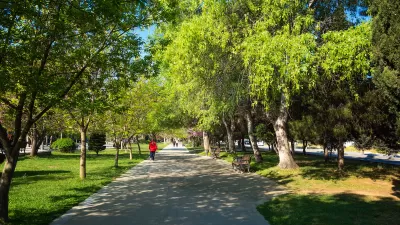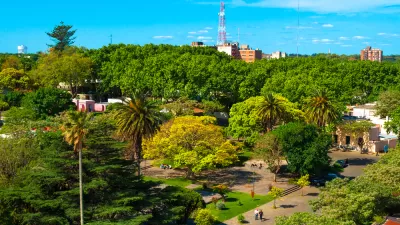As climate change intensifies the urban heat island effect, poorer neighborhoods bear the brunt of tree canopy inequity.

"There are certain visual clues that identify the socioeconomic status of an urban neighborhood," writes Natalie Bicknell, "and in the United States one of these is the presence — or absence — of trees." In order to achieve equity in tree canopy coverage, U.S. cities should plant 522 million trees in urban areas, according to a new tool called the Tree Equity Score (TES). "Combining GIS (Geographic Information System) mapping data with information provided by the United States census on population density, demographics of residents, health trends, and urban heat indexes, the TES uses quantitative analysis to determine whether locations have enough trees to provide optimal health, economic and climate benefits to residents."
An assessment of TES data shows that "[o]n average, American neighborhoods home to a majority of people of color have 33% less tree canopy than majority White neighborhoods," while "neighborhoods with 90% or more of their residents living in poverty have 41% less tree canopy than communities with only 10% or less of the population in poverty." The recent heat wave experienced by the Pacific Northwest brought out the reality of these numbers as close to 100 people in Washington and Oregon died from heat-related causes. "In the Canadian province of British Columbia, the heatwave is thought to have contributed to over 700 sudden deaths in a single week." Meanwhile, the U.S. is losing trees: "approximately one tree is lost for every two trees planted or naturally regenerated in urban areas," which will lead to a decline in tree canopy of 8.3% by 2060.
"The path to planting 522 million trees in urban areas will be a long one, but reframing how trees are viewed in cities might accelerate the process," writes Bicknell. Along with tools like the TES and the National Tree Benefit Calculator (NTBC), "considering trees to be core urban infrastructure and treating them as such could lead to a revaluation of trees in urban settings, provoking cities to invest more in planting and caring for them."
FULL STORY: In Order to Achieve Tree Equity, the U.S. Must Plant 522 Million Trees in Urban Areas

Planetizen Federal Action Tracker
A weekly monitor of how Trump’s orders and actions are impacting planners and planning in America.

Maui's Vacation Rental Debate Turns Ugly
Verbal attacks, misinformation campaigns and fistfights plague a high-stakes debate to convert thousands of vacation rentals into long-term housing.

Cuomo Is the Candidate of Both NIMBYs and Developers. What Gives?
In the New York City mayoral race, odd bedfellows align to preserve the housing status quo.

The Subversive Car-Free Guide to Trump's Great American Road Trip
Car-free ways to access Chicagoland’s best tourist attractions.

San Antonio and Austin are Fusing Into one Massive Megaregion
The region spanning the two central Texas cities is growing fast, posing challenges for local infrastructure and water supplies.

Charlottesville Temporarily Has No Zoning Code
A judge ordered the Virginia city to throw out its newly revised zoning code, leaving permitting for new development in legal limbo.
Urban Design for Planners 1: Software Tools
This six-course series explores essential urban design concepts using open source software and equips planners with the tools they need to participate fully in the urban design process.
Planning for Universal Design
Learn the tools for implementing Universal Design in planning regulations.
Heyer Gruel & Associates PA
JM Goldson LLC
Custer County Colorado
City of Camden Redevelopment Agency
City of Astoria
Transportation Research & Education Center (TREC) at Portland State University
Jefferson Parish Government
Camden Redevelopment Agency
City of Claremont





























